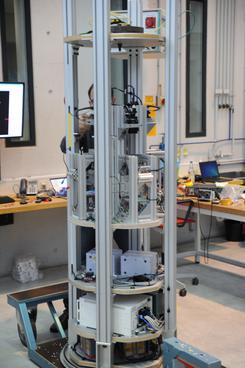Inertial Spreading and Imbibition of a Liquid Drop Through a Porous Surface (Dropping Drops)

research area: fluid dynamics
experiment title:
Inertial Spreading and Imbibition of a Liquid Drop Through a Porous Surface (Dropping Drops)
experiment acronym: DYT
funding agency:
ESA (Education) / ZARM
grant number:
Drop Your Thesis! - Program
performing organization:
Institute for Multiscale Simulation, Friedrich-Alexander Universität Erlangen-Nürnberg, Germany
prime investigator:
Prof. Dr. Thorsten Pöschel
(Laura Steub, Fabian Zimber, Jonathan Kollmer)
experiment objective
abstract
When a liquid droplet touches a porous surface, its penetration is first inhibited by a short inertial phase, followed by a longer regime dominated by viscosity. Although the inertial phase governs the dynamics of penetration, it is nearly impossible to observe it on Earth, as drops must be very small to avoid being deformed by gravity. As a result, the inertial phase has so far only been studied with numerical simulations, which our microgravity experiments intend to validate. In the ZARM drop tower, residual gravity is low enough to stage large centimetric drops, which our unique apparatus has successfully generated by separating two hemispheres coated with a water repellent. The student team from the Friedrich-Alexander-University (FAU) Erlangen-Nürnberg will use a high-speed camera to trace the penetration of large drops in several porous media and thus gauge the accuracy of simulations. We are supervised by Thorsten Pöschel and Jonathan Kollmer at the FAU, and we collaborate with Patrick Perré at the Ecole Centrale in Paris, who produced the numerical simulations, and Michel Louge at Cornell University, who helped with development of the experiment.
related publications
- Inertial Spreading and Imbibition of a Liquid Drop Through a Porous Surface (Dropping Drops), Drop Your Thesis! 2015 - Final Report. ESA Human Spaceflight and Exploration, Erasmus Experiment Archive
experiment campaigns
experiment year: 2015
number of drops: 5


 "
"